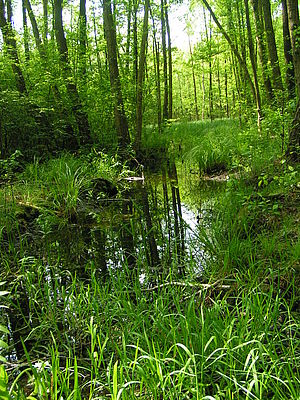Upon my arrival at the Sungei Buloh wetland reserve (SBWR) this September, I had only visited a mangrove forest in Tainan, Taiwan on a boat briefly. I was really looking forward to my first in-depth field excursion to a mangrove forest with Prof Gretchen and my NUS GE3255 class. Coming from Germany, my understanding of ‘the forest’ consisted of seasonally lush green places, emitting calmness, peace, and serenity – accompanied by occasional bird sounds or other animals’ presence. But this association changed after arriving at the SBWR and being overwhelmed by the sound of cicadas.

Fig. 1 Sungei Buloh mangrove forest at low tide (credit: Liska Wohlgemuth, 2022)
SBWR is a primarily tropical coastal mangrove wetland ecosystem located in the Northwest of Singapore (Fig. 1). This reserve is characterised by 202 ha of brackish man-made tidal ponds, estuaries, tidal channels, intertidal mudflats, as well as mature mangroves and fringing mangroves. The Spreewald (“Spree Forest“) is a 475 km ² big, natural UNESCO biosphere reserve in the Southeast of Berlin, consisting of wetland, wetland meadows, riverside meadows, and rivers. While both ecosystems are wetlands, they differ in a lot of aspects (Fig. 2 & 3).

Fig. 3 Coastal mangrove forest (credit: Liska Wohlgemuth, 2022)
The first main characteristic of a mangrove forest is the importance of the hydrological flow (mix of seawater and freshwater that forms brackish water) and the semidiurnal tidal cycle of 2 low and 2 high tides each day. On the other hand, the Spreewald is an inland delta consisting of wetland forest and bogs, formed after the Weichselian glaciation through an anastomosing freshwater system.
Secondly, the high biodiversity found in mangroves is another important characteristic. SBWR is known for its high biodiversity in plant and animal species (Fig. 4-6). More than 212 local and migratory bird species, including nationally and globally endangered species, roost and feed here. Other prominent species are the smooth coated otter, the palm civet, the long-tailed macaques, the crocodiles, and the most frequent animal visitor during our field trip: the monitor lizard. Although the Spreewald also is rich in biodiversity with its approximately 303 local and migratory bird species, the local and migratory species are different from the ones found in Singapore.

Fig. 4 Most prominetn fish species found in Sungei Buloh Besar (credit: Liska Wohlgemuth, 2022)

Fig. 5 Our field trip guide: the monitor lizard (credit: Liska Wohlgemuth, 2022)

Fig. 6 A group of Common Redshanks at the Buloh Tidal Ponds (credit: Liska Wohlgemuth, 2022)
Finally, the mangrove ecosystem is a coastal ecosystem that prevents erosion through stabilization of the soil by specialized mangrove stilt roots. From the seaward zone to the middle zone and then the back zone, the soil characteristic changes from soft, loose, and flooded to higher clay content and only occasionally flooding. This difference of soil composition allows different mangroves as well as other plant species to thrive. Therefore, forming a regulating service of carbon sequestration (capturing and storing of CO2), erosion prevention and buffer zone for landmass protection, in addition to function as a pollutant and nutrients filter.
This mix of different abiotic and biotic factors makes the Singaporean mangrove ecosystem so special and unique, and important for fighting against climate change, flooding, and urbanization as well as biodiversity loss.
Written by: Liska Wohlgemuth


Leave a Reply